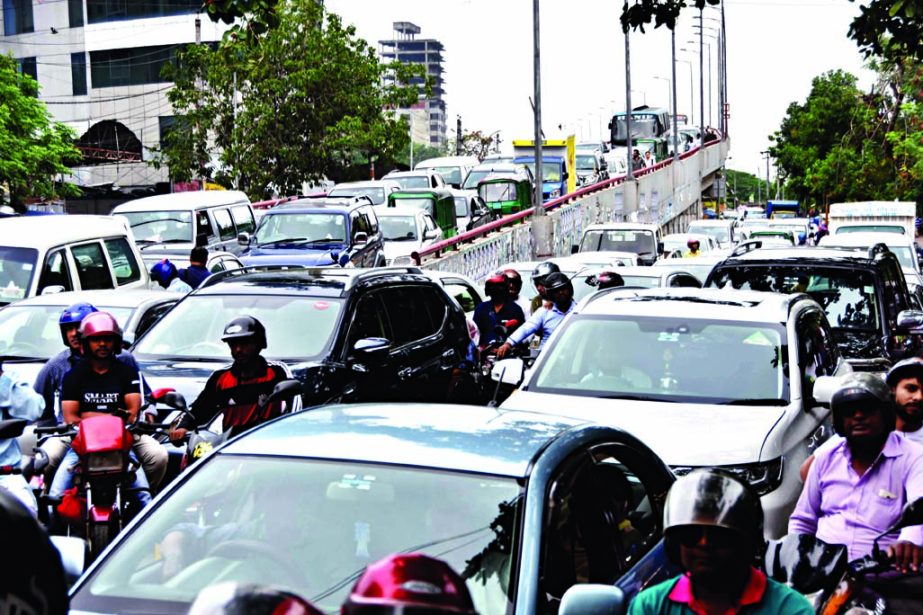
Special Correspondent :
People are yet to get any relief from the city’s nagging traffic jam though the authorities built several flyovers in and around the capital Dhaka costing over Tk 4,000 crore.
It was commonly believed that building these mega infrastructures could solve the city’s traffic problems and reduce commuters’ sufferings.
But the roads got chocked again within a short period of erecting such mega infrastructures, as they tend to merely shift the point of congestion from one location to another and commuters have to bear the brunt.
Experts and city dwellers have now started raising questions over the effectiveness of these high-cost mega infrastructures.
An effective solution to the city’s traffic gridlock lies on proper planning, increasing public transport planning and rapid decentralization, they opine.
“I do not see them (flyovers) as solutions to traffic congestion though they are being constructed in an isolated manner within the city,” Dr Shamsul Haque, a professor of Civil Engineering Department of Bangladesh University of Engineering and Technology (BUET) and an expert on Road and Transportation infrastructures, told The New Nation.
Even, he said, traffic congestion is getting worse at the landing points of flyovers’ ramps resulting in serpentine queues of vehicles. Such a situation persists all daylong at city’s Banglamotor, Sonargaon and Banani point where vehicles were found stranded for hours.
When asked, Dr Shamsul Haque said, there is no proof that the flyovers erected within the city have been able to add any benefit rather intensified the traffic chaos.
“Capital Dhaka is no exception of this as flyovers built within the heart of the city only increased the traffic flow at their both ends resulting in roads gridlock quickly. Besides, ever-increasing number of private cars worsens the situation further,” he added.
He cited that the government must increase the number of mass transports like buses, bring discipline on traffic movement and adopt decentralization process to ease the traffic congestion.
In the last decade, the government spent a staggering Tk 28,000 crore to ease traffic congestion in Dhaka. But the net result is that the average speed of motor vehicles in the city has come down to 4.5 kilometres per hour – which is lower than the walking speed.
About 12 years ago, average motor vehicle speed in the city was 21 kilometres per hour, according to a study of the Bangladesh University of Engineering and Technology.
The study notes that the nation could have saved Tk 22,000 crore a year in terms of productivity if traffic jam could be reduced by 60 per cent.
“City dwellers did not get respite from traffic gridlock though flyovers were built with huge investments. Commuters had to stuck up on flyovers during peak hours in working days as they failed to relieve congestion,” Tofail Ahmed, a city dweller, told The New Nation.
He observed construction of flyovers has complicated the city’s traffic situation further and the commuters bear the brunt of it.
“The authorities should increase the alternative modes of transports to reduce the hazard of gridlock in Dhaka and increase number of public buses to meet the transport demand of different classes,” he added.
“Traffic congestion in Dhaka city has intensified due to lack of planning and preparation over previous decades, and an over-reliance on cars in absence of smooth public transport system,” said Iqbal Habib, an urban planner.
He said an increased number of flyovers did not help improve the situation because the city lacks a sophisticated transport infrastructure.
“Building flyovers in the inner parts of a city brings no solution. The solution lies on improved traffic management, facilitating alternative transportation modes and reduction of private cars,” he added.
He also emphaised the need for quick introduction of the much-anticipated ‘route franchise’ system and enforce stringent traffic rules to bring discipline in city roads as well public transport system.
Experts also suggested the authorities to focus more on cost-effective solutions like elevated U-turns and underpasses to keep traffic moving in the city’s several chokepoints.

